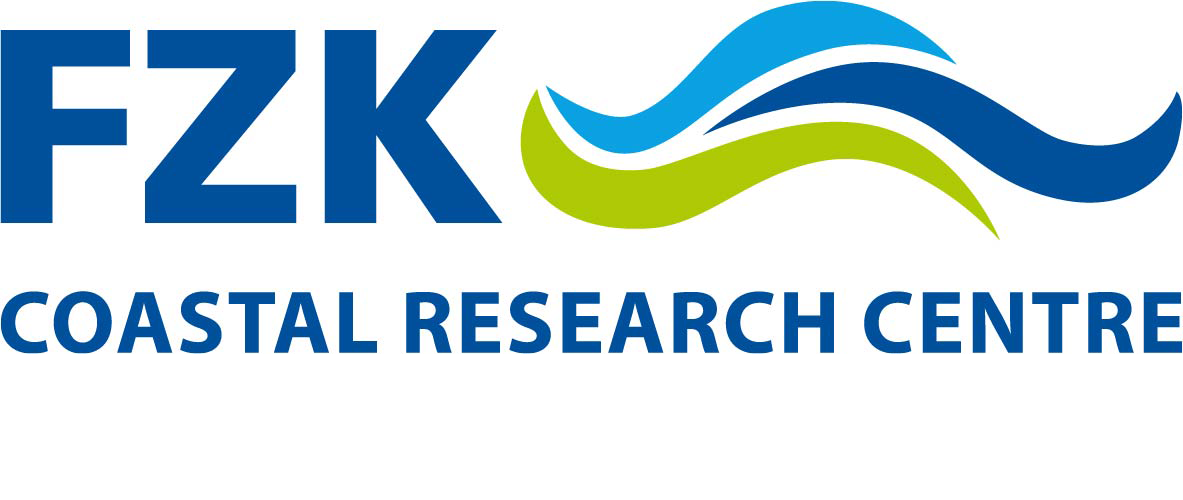Focused wave experiments (HyReS)
| Led by: | Dr.-Ing. Stefan Schimmels |
| E-Mail: | schimmels@fzk.uni-hannover.de |
| Team: | n Dr. Hernán Fernandez |
| Year: | 2014 |
| Funding: | u HYDRALAB IV |
| Remarks: | 2 weeks |
Freak or rogue waves are associated with major damages at coastal or offshore structures. Hence, a proper design of these kinds of structures requires in depth knowledge about extreme wave events. In laboratory flumes the generation of extreme wave events is therefore very important and realized by means of nonlinear superposition and phasing of individual wave components, a technique which is commonly termed as wave focusing.
Most of the methods to generate focused waves are based on linear theory to propagate the target wave profile backwards to the position of the wave maker. Thus, small changes in the wave paddle driving signal lead to important shifts at the concentration point, this is due to when a wave packet containing different frequencies is generated, new components which do not satisfy linear dispersion relation are created. Therefore the individual wave components will not perfectly focus at the desired location and instant and premature focusing is observed in most of the cases.
In this case, a Self-Correcting-Method (SCM) has been applied in order to overcome the mentioned issues and to produce accurate wave focusing at the desired location for any kind of experimental set-up. The SCM is a proper way to improve the quality of the control signal by means of taking into account the inherent nonlinear interactions in the resulting wave train. If one knows the experimental set up to be used, the efficiency of the wave focusing is iteratively improved in terms of the differences (spectral phases and amplitudes) between the target and the recorded wave profile.
As physical testing is expensive and time consuming, especially in large scale laboratories like the Large Wave Flume (Großer Wellenkanal, GWK), the iteration steps are performed in a very accurate NWT based on potential flow theory. Thus, the improved control signal is used to drive the wave generator of the GWK.
The validation of the methodology presented above was carried out in the GWK. The verification tests were conducted within the WAVESLAM project. The physical model was deployed in 2 m water depth at x = 198.4 m from the wave maker. Then the water depth linearly increases with a 1:10 slope from d = 2.0 m to d = 4.3 m where it remains constant until the position of the wave maker.
Both non breaking and breaking focused waves were tested. Following the methodology the SCM was developed in the NWT and the control signal was generated in GWK. Very good agreement between the experimental and the numerical data is reported, the slight deviation after the focusing is due to the wave reflection from the truss structure is not considered in the NWT.
For purpose of completeness in the validation procedure, a non breaking focused wave over constant water depth (x < 175 m) was also generated with the model setup presented previously, but the water depth was lowered until d = 3.5 m. The parameters defining the wave focusing were: d = 3.5 m, xf = 140 m, tf = 85 s, Δf = 0.31 Hz, fc = 0.31 Hz, G = 0.003*π, N = 32. It is important to mention that in general both (numerical and experimental) signals present a relative good agreement for the main wave crest with slight deviations at the wave troughs. This validation test confirms that the proposed methodology is capable to produce accurate steep non breaking focused waves also over constant water depth.
The second validation test corresponds to a breaking focused wave case, the procedure is repeated and the control signal is improved within the NWT by means of the SCM. Using the aforementioned set up, the wave parameters defining the test case are: xf = 190 m, tf = 64 s, Δf = 0.2 Hz, fc = 0.204 Hz, G = 0.0025*π, N = 32. The focal point is located over the slope, where the water depth is d = 2.81 m. It is important to mention that here the agreement between the physical and the numerical data is quite satisfying nevertheless the numerical model slightly underestimates the extreme values. The comparison between the experimental and theoretical wave elevation shows that although the agreement between profiles is lower respect to the previous cases (the experimental result is steeper, higher and asymmetric respect to the theoretical one), the energy is concentrated at the predefined location.
